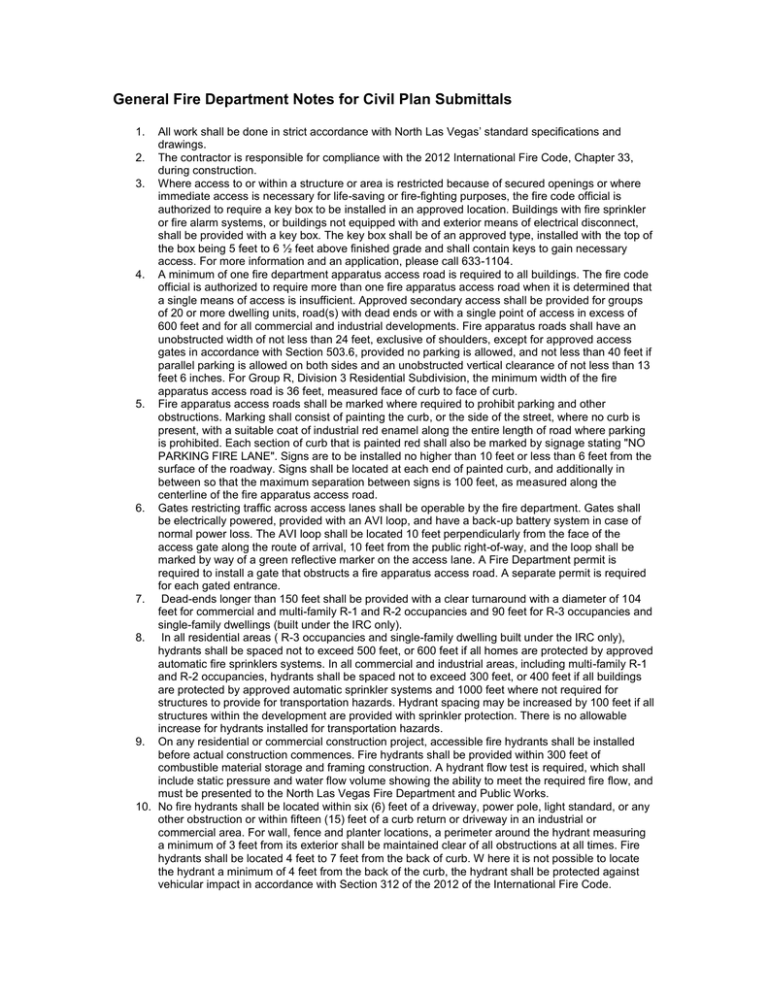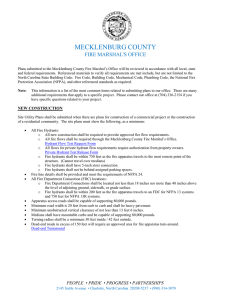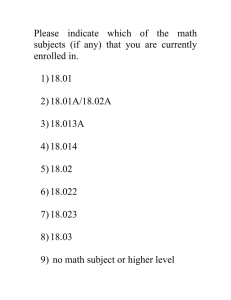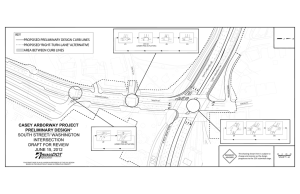General Fire Department Notes for Civil Plan Submittals
advertisement

General Fire Department Notes for Civil Plan Submittals All work shall be done in strict accordance with North Las Vegas’ standard specifications and drawings. 2. The contractor is responsible for compliance with the 2012 International Fire Code, Chapter 33, during construction. 3. Where access to or within a structure or area is restricted because of secured openings or where immediate access is necessary for life-saving or fire-fighting purposes, the fire code official is authorized to require a key box to be installed in an approved location. Buildings with fire sprinkler or fire alarm systems, or buildings not equipped with and exterior means of electrical disconnect, shall be provided with a key box. The key box shall be of an approved type, installed with the top of the box being 5 feet to 6 ½ feet above finished grade and shall contain keys to gain necessary access. For more information and an application, please call 633-1104. 4. A minimum of one fire department apparatus access road is required to all buildings. The fire code official is authorized to require more than one fire apparatus access road when it is determined that a single means of access is insufficient. Approved secondary access shall be provided for groups of 20 or more dwelling units, road(s) with dead ends or with a single point of access in excess of 600 feet and for all commercial and industrial developments. Fire apparatus roads shall have an unobstructed width of not less than 24 feet, exclusive of shoulders, except for approved access gates in accordance with Section 503.6, provided no parking is allowed, and not less than 40 feet if parallel parking is allowed on both sides and an unobstructed vertical clearance of not less than 13 feet 6 inches. For Group R, Division 3 Residential Subdivision, the minimum width of the fire apparatus access road is 36 feet, measured face of curb to face of curb. 5. Fire apparatus access roads shall be marked where required to prohibit parking and other obstructions. Marking shall consist of painting the curb, or the side of the street, where no curb is present, with a suitable coat of industrial red enamel along the entire length of road where parking is prohibited. Each section of curb that is painted red shall also be marked by signage stating "NO PARKING FIRE LANE". Signs are to be installed no higher than 10 feet or less than 6 feet from the surface of the roadway. Signs shall be located at each end of painted curb, and additionally in between so that the maximum separation between signs is 100 feet, as measured along the centerline of the fire apparatus access road. 6. Gates restricting traffic across access lanes shall be operable by the fire department. Gates shall be electrically powered, provided with an AVI loop, and have a back-up battery system in case of normal power loss. The AVI loop shall be located 10 feet perpendicularly from the face of the access gate along the route of arrival, 10 feet from the public right-of-way, and the loop shall be marked by way of a green reflective marker on the access lane. A Fire Department permit is required to install a gate that obstructs a fire apparatus access road. A separate permit is required for each gated entrance. 7. Dead-ends longer than 150 feet shall be provided with a clear turnaround with a diameter of 104 feet for commercial and multi-family R-1 and R-2 occupancies and 90 feet for R-3 occupancies and single-family dwellings (built under the IRC only). 8. In all residential areas ( R-3 occupancies and single-family dwelling built under the IRC only), hydrants shall be spaced not to exceed 500 feet, or 600 feet if all homes are protected by approved automatic fire sprinklers systems. In all commercial and industrial areas, including multi-family R-1 and R-2 occupancies, hydrants shall be spaced not to exceed 300 feet, or 400 feet if all buildings are protected by approved automatic sprinkler systems and 1000 feet where not required for structures to provide for transportation hazards. Hydrant spacing may be increased by 100 feet if all structures within the development are provided with sprinkler protection. There is no allowable increase for hydrants installed for transportation hazards. 9. On any residential or commercial construction project, accessible fire hydrants shall be installed before actual construction commences. Fire hydrants shall be provided within 300 feet of combustible material storage and framing construction. A hydrant flow test is required, which shall include static pressure and water flow volume showing the ability to meet the required fire flow, and must be presented to the North Las Vegas Fire Department and Public Works. 10. No fire hydrants shall be located within six (6) feet of a driveway, power pole, light standard, or any other obstruction or within fifteen (15) feet of a curb return or driveway in an industrial or commercial area. For wall, fence and planter locations, a perimeter around the hydrant measuring a minimum of 3 feet from its exterior shall be maintained clear of all obstructions at all times. Fire hydrants shall be located 4 feet to 7 feet from the back of curb. W here it is not possible to locate the hydrant a minimum of 4 feet from the back of the curb, the hydrant shall be protected against vehicular impact in accordance with Section 312 of the 2012 of the International Fire Code. 1. 11. The minimum fire-flow and flow duration for buildings other than one- and two-family dwellings shall be as specified in Table B105.1. For buildings other than high-rise buildings, a reduction in required fire flow of up to 50 percent, as approved, is allowed when the building is provided with an approved automatic sprinkler system installed in accordance with Section 903.3.1.1 or 903.3.1.2. A reduction in the required fire flow of up to 25 percent is permitted in high-rise buildings. The resulting fire flow shall not be less than 1,500 gallons per minute (95678 L/min) for the prescribed duration as specified in table B105.1. 12. When automatic fire protection is required, the fire department connection (FDC) shall be so located that fire apparatus and hose connected to supply the system will not obstruct access to the building for other fire apparatus. It shall be located on the street side of buildings, fully visible and recognizable from the street or nearest point of fire department vehicle access. Immediate access to FDC shall be maintained at all times and without obstruction by fences, bushes, trees, walls or any other fixed or moveable object. A working space of not less than 36 inches in width, 36 inches in depth and 78 inches in height not including any doors or windows, shall be provided and maintained in front of and to the sides of wall-mounted fire department connections and around the circumference of freestanding fire department connections. The maximum distance from a fire hydrant to a fire department connection (FDC) supplying fire sprinklers and/or standpipes shall not exceed 100 feet, as measured by an approved route. An approved route is defined as an unobstructed path of travel on which fire apparatus can maneuver and on which hose can easily be laid.



